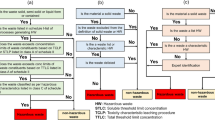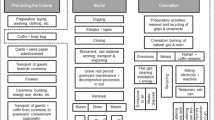Abstract
Purpose
In order to improve and support decision-making for the selection of remedial techniques for contaminated sites, a multi-criteria assessment (MCA) method has been developed. The MCA framework is structured in a decision process actively involving stakeholders, and compares the sustainability of remediation alternatives by integrating environmental, societal, and economic criteria in the assessment.
Materials and methods
The MCA includes five main decision criteria: remedial effect, remediation cost, remediation time, environmental impacts, and societal impacts. The main criteria are divided into a number of sub-criteria. The environmental impacts consider secondary impacts to the environment caused by remedial activities and are assessed by life-cycle assessment (LCA). The societal impacts mainly consider local impacts and are assessed in a more qualitative manner on a scale from 1 to 5. The performance on each main criterion is normalized to a score between 0 and 1, with 1 being the worst score. An overall score is obtained by calculating a weighted sum with criteria weights determined by stakeholders. The MCA method was applied to assess remediation alternatives for the Groyne 42 site, one of the largest contaminated sites in Denmark.
Results and discussion
The compared remediation alternatives for the site were: (1) excavation of the site followed by soil treatment; (2) in situ alkaline hydrolysis; (3) in situ thermal remediation; and (4) continued encapsulation of the site by sheet piling. Criteria weights were derived by a stakeholder panel. The stakeholders gave the highest weighting to the remedial effect of the methods and to the societal impacts. For the Groyne 42 case study, the excavation option obtained the lowest overall score in the MCA, and was therefore found to be the most sustainable option. This was especially due to the fact that this option obtained a high score in the main categories Effect and Social impacts, which were weighted highest by the stakeholders.
Conclusions
The developed MCA method is structured with five main criteria. Effect and time are included in addition to the three pillars of sustainability (environment, society, and economy). The remedial effect of remediation is therefore assessed and weighted separately from the main criteria environment. This structure makes interpretation of criteria scores more transparent and emphasizes the importance of effect and time as decision parameters. This also facilitated an easier weighting procedure for the stakeholders in the case study, who expressed a wish to weigh the remedial effect independently from the secondary environmental impacts.






Similar content being viewed by others
References
AFCEE (2010) SRT. Sustainable remediation tool. User guide. May 2010. Air Force Center for Engineering and the Environment (AFCEE)
Beames A, Broekx S, Lookman R, Touchant K, Seuntjens P (2014) Sustainability appraisal tools for soil and groundwater remediation: how is the choice of remediation alternative influenced by different sets of sustainability indicators and tool structures? Sci Total Environ 470-471:954–966
Beinat E, van Drunen M, Janssen R, Nijboer M, Koolenbrander JGM, Okx JP, Schütte AR (1997) REC: a methodology for comparing soil remedial alternatives based on the criteria of risk reduction, environmental merit and costs. September 1997, CUR/NOBIS
Brinkhoff P (2011) Multi-criteria analysis for assessing sustainability of remedial actions - applications in contaminated land development. A literature review. Chalmers University of Technology, Department of Civil and Environmental Engineering, Gothenburg, Sweden. Report 2011:14
Cappuyns V (2016) Inclusion of social indicators in decision support tools for the selection of sustainable site remediation options. J Environ Manag 184:45–56
Finansministeriet (2013) Ny og lavere samfundsøkonomisk diskonteringsrate. Faktaark. Finansministeriet, 31. Maj 2013. Downloaded at https://www.fm.dk/nyheder/pressemeddelelser/2013/05/ny-og-lavere-samfundsoekonomisk-diskonteringsrente
Fjordbøge AS, Bjerg PL, Binning PJ, Poulsen SE (2014) NorthPestClean: remediation stop criteria. Project no.: Life09/ENV/DK368. Technical University of Denmark, Aarhus University, the Region of Central Denmark. June 2014
Freeman RE (1984) Strategic management: a stakeholder approach. Pitman Publishing, Boston
Frischknecht R, Jungbluth N, Althaus HJ, Doka G, Dones R, Heck T, Hellweg S, Hischier R, Nemecek T, Rebitzer G, Spielmann M, Wernet G (2007) Overview and methodology. ecoinvent report No. 1. Swiss Centre for Life Cycle Inventories, Dübendorf
Golder Associates (n.d.) GOLDSET: Decision support tools across project life cycle. Golder Associates www.goldset.com
Harbottle MJ, Al-Tabbaa A, Evans CW (2008) Sustainability of land remediation. Part 1: overall analysis. Proc Inst Civ Eng - Geotech Eng 161:75–92
Hauschild MZ, Potting J (2005) Spatial differentiation in life cycle impact assessment - the EDIP-2003 methodology. Environmental news No. 80 2005, Environmental Protection Agency, Danish Ministry of the Environment
Holland KS (2011) A framework for sustainable remediation. Environ Sci Technol 2011:7116–7007
Hou D, Al-Tabbaa A (2014) Sustainability: a new imperative in contaminated land remediation. Environ Sci Pol 39:25–34
Huysegoms L, Cappuyns V (2017) Critical review of decision support tools for sustainability assessment of site remediation options. J Environ Manag 196:278–296
Keeney RL, Raiffa H (1976) Decisions with multiple objectives: performances and value trade-offs. Wiley, New York
Keeney RL, Raiffa H (1993) Decision with multiple objectives: preferences and value tradeoffs. Cambridge University Press, Cambridge
Kiker GA, Bridges TS, Varghese A, Seager TP, Linkov I (2005) Application of multicriteria decision analysis in environmental decision making. Integr Environ Assess Manag 1(2):95–108
Laurent A, Lautier A, Rosenbaum RK, Olsen SI, Hauschild MZ (2011a) Normalization references for Europe and North America for application with USEtox ™ characterization factors. Int J Life Cycle Assess 16:728–738
Laurent A, Olsen SI, Hauschild MZ (2011b) Normalization in EDIP97 and EDIP2003: updated European inventory for 2004 and guidance towards a consistent use in practice. Int J Life Cycle Assess 16:401–409
LCA Center (2005) List of EDIP factors downloaded from LCA Center Denmark 04–11-2008 at http://www.lca-center.dk/cms/site.aspx?p=1595
Lemming G, Chambon J, Binning PJ, Bulle C, Margni M, Bjerg PL (2010a) Environmental impacts of remediation of a trichlor oethene-contaminated site: life cycle assessment of remediation alternatives. Environ Sci Technol 44:9163–9169
Lemming G, Hauschild MZ, Bjerg PL (2010b) Life cycle assessment of soil and groundwater remediation technologies: literature review. Int J Life Cycle Assess 15:115–127
Lemming G, Chambon JC, Binning PJ, Bjerg PL (2012) Is there an environmental benefit from remediation of a contaminated site? Combined assessments of the risk reduction and life cycle impact of remediation. J Environ Manag 112:392–403
Lemming G, Nielsen SG, Weber K, Heron G, Baker RS, Falkenberg JA, Terkelsen M, Jensen CB, Bjerg PL (2013) Optimizing the environmental performance of in situ thermal remediation technologies using life cycle assessment. Ground Water Monit Remediat 33(3):38–51
Linkov I, Seager TP (2011) Coupling multi-criteria decision analysis, life-cycle assessment, and risk assessment for emerging threats. Environ Sci Technol 45:5068–5074
Marttunen M, Mustajoki J, Dufva M, Karjalainen TP (2015) How to design and realize participation of stakeholders in MCDA processes? A framework for selecting an appropriate approach. EURO J Decis Process 3:187–214
Morais SA, Delerue-Matos C (2010) A perspective on LCA application in site remediation services: critical review of challenges. J Hazard Mater 175:12–22
NICOLE (2010) Road map for sustainable remediation. Network for industrially contaminated land in Europe. Issued September 2010
Roberts R, Goodwin P (2002) Weight approximations in multiattribute decision models. J Multi-Criteria Decis Anal 303:291–303
Rosén L, Back PE, Söderqvist T, Norrman J, Brinkhoff P, Norberg T, Volchko Y, Norin M, Bergknut M, Döberl G (2015) SCORE: a novel multi-criteria decision analysis approach to assessing the sustainability of contaminated land remediation. Sci Total Environ 511:621–638
Rosenbaum RK, Bachmann TM, Gold LS, Huijbregts MAJ, Jolliet O, Juraske R, Koehler A, Larsen HF, MacLeod M, Margni M, McKone TE, Payet J, Schuhmacher M, van de Meent D, Hauschild MZ (2008) USEtox - the UNEP-SETAC toxicity model: recommended characterisation factors for human toxicity and freshwater ecotoxicity in life cycle impact assessment. Int J Life Cycle Assess 13:532–546
Saaty RW (1987) The analytic hierarchy process-what it is and how it is used. Math Model 9:161–176
Söderqvist T, Brinkhoff P, Norberg T, Rosén L, Back P-E, Norrman J (2015) Cost-benefit analysis as a part of sustainability assessment of remediation alternatives for contaminated land. J Environ Manag 157:267–278
Sorvari J, Seppälä J (2010) A decision support tool to prioritize risk management options for contaminated sites. Sci Total Environ 408:786–1799
Sparrevik M, Barton DN, Oen AMP, Sehkar NU, Linkov I (2011) Use of multicriteria involvement processes to enhance transparency and stakeholder participation at Bergen Harbor, Norway. Integr Environ Assess Manag 7:414–425
Sparrevik M, Barton DN, Bates ME, Linkov I (2012) Use of stochastic multi-criteria decision analysis to support sustainable management of contaminated sediments. Environ Sci Technol 46:1326–1334
SuRF-UK (2010) A Framework for Assessing the Sustainability of Soil and Groundwater Remediation. Sustainable Remediation Forum UK. Published by Contaminated Land: Applications in Real Environments (CL:AIRE), London, March 2010
SuRF-UK (2013a) SuRF-UK bulletin. Upper Heyford – Remediation Options Appraisal. SuRF 2. September 2013. CL:AIRE Accessed 26–07-2016 at http://www.claire.co.uk/projects-and-initiatives/surf-uk/22-supporting-materials/95-surf-uk-case-studies-and-bulletins
SuRF-UK (2013b) SuRF-UK bulletin. Helpston Contaminated Land Project. SuRF 3. September 2013. CL:AIRE. Accessed 26–07-2016 at http://www.claire.co.uk/projects-and-initiatives/surf-uk/22-supporting-materials/95-surf-uk-case-studies-and-bulletins
UN (1987) Report of the world commission on environment and development: our common future. General Assembly Resolution 42/187, 11 December 1987
United States Navy, United States Army Corps of Engineers, Batelle (2015) SiteWise™ Version 3.1, User guide. September 2015
Van Liedekerke M, Prokop G, Rabl-Berger S, Kibblewhite M, Louwagie G (2014) Progress in the Management of Contaminated Sites in Europe, joint research center. Reference Report. European Commission
Acknowledgements
The authors wish to acknowledge K. Rügge, Cowi, and S.G. Nielsen, Niras/TerraTherm for estimating the consumables, time frame, and remedial effect of the alkaline hydrolysis, and thermal remediation technologies, respectively. A working group from the Central Denmark Region consisting of A. Melvej, B. Hvidberg, K. Rüegg, and L. Ernst provided valuable input to the Groyne 42 site assessment.
Author information
Authors and Affiliations
Corresponding author
Additional information
Responsible editor: Jenny Norrman
Electronic supplementary material
ESM 1
(DOCX 93 kb)
Rights and permissions
About this article
Cite this article
Søndergaard, G.L., Binning, P.J., Bondgaard, M. et al. Multi-criteria assessment tool for sustainability appraisal of remediation alternatives for a contaminated site. J Soils Sediments 18, 3334–3348 (2018). https://doi.org/10.1007/s11368-017-1805-2
Received:
Accepted:
Published:
Issue Date:
DOI: https://doi.org/10.1007/s11368-017-1805-2




